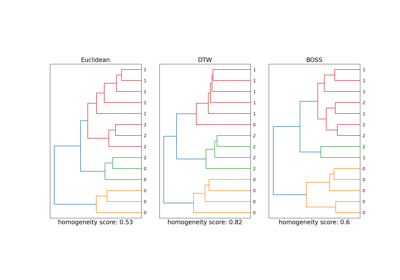pyts.transformation.BOSS¶
-
class
pyts.transformation.BOSS(word_size=4, n_bins=4, strategy='quantile', window_size=10, window_step=1, anova=False, drop_sum=False, norm_mean=False, norm_std=False, numerosity_reduction=True, sparse=True, alphabet=None)[source]¶ Bag of Symbolic Fourier Approximation Symbols.
For each time series, subseries are extracted using a sliding window. Then the subseries are transformed into a word using the Symbolic Fourier Approximation (SFA) algorithm. For each time series, the words are grouped together and a histogram counting the occurences of each word is created.
Parameters: - word_size : int (default = 4)
Size of each word.
- n_bins : int (default = 4)
The number of bins to produce. It must be between 2 and 26.
- strategy : str (default = ‘quantile’)
Strategy used to define the widths of the bins:
- ‘uniform’: All bins in each sample have identical widths
- ‘quantile’: All bins in each sample have the same number of points
- ‘normal’: Bin edges are quantiles from a standard normal distribution
- ‘entropy’: Bin edges are computed using information gain
- window_size : int or float (default = 10)
Size of the sliding window. If float, it represents the percentage of the size of each time series and must be between 0 and 1. The window size will be computed as
ceil(window_size * n_timestamps).- window_step : int or float (default = 1)
Step of the sliding window. If float, it represents the percentage of the size of each time series and must be between 0 and 1. The window size will be computed as
ceil(window_step * n_timestamps).- anova : bool (default = False)
If True, the Fourier coefficient selection is done via a one-way ANOVA test. If False, the first Fourier coefficients are selected.
- drop_sum : bool (default = False)
If True, the first Fourier coefficient (i.e. the sum of the subseries) is dropped. Otherwise, it is kept.
- norm_mean : bool (default = False)
If True, center each subseries before scaling.
- norm_std : bool (default = False)
If True, scale each subseries to unit variance.
- numerosity_reduction : bool (default = True)
If True, delete sample-wise all but one occurence of back to back identical occurences of the same words.
- sparse : bool (default = True)
Return a sparse matrix if True, else return an array.
- alphabet : None, ‘ordinal’ or array-like, shape = (n_bins,)
Alphabet to use. If None, the first n_bins letters of the Latin alphabet are used.
References
[1] P. Schäfer, “The BOSS is concerned with time series classification in the presence of noise”. Data Mining and Knowledge Discovery, 29(6), 1505-1530 (2015). Examples
>>> from pyts.datasets import load_gunpoint >>> from pyts.transformation import BOSS >>> X_train, X_test, _, _ = load_gunpoint(return_X_y=True) >>> boss = BOSS(word_size=2, n_bins=2, sparse=False) >>> boss.fit(X_train) BOSS(...) >>> sorted(boss.vocabulary_.values()) ['aa', 'ab', 'ba', 'bb'] >>> boss.transform(X_test) array(...)
Attributes: - vocabulary_ : dict
A mapping of feature indices to terms.
Methods
__init__([word_size, n_bins, strategy, …])Initialize self. fit(X[, y])Fit the model according to the given training data. fit_transform(X[, y])Fit the data then transform it. get_params([deep])Get parameters for this estimator. set_params(**params)Set the parameters of this estimator. transform(X)Transform the provided data. -
__init__(word_size=4, n_bins=4, strategy='quantile', window_size=10, window_step=1, anova=False, drop_sum=False, norm_mean=False, norm_std=False, numerosity_reduction=True, sparse=True, alphabet=None)[source]¶ Initialize self. See help(type(self)) for accurate signature.
-
fit(X, y=None)[source]¶ Fit the model according to the given training data.
Parameters: - X : array-like, shape = (n_samples, n_timestamps)
Training vector.
- y : None or array-like, shape = (n_samples,)
Class labels for each data sample.
Returns: - self : object
-
fit_transform(X, y=None)[source]¶ Fit the data then transform it.
Parameters: - X : array-like, shape = (n_samples, n_timestamps)
Training vector.
- y : None or array-like, shape = (n_samples,)
Class labels for each data sample.
Returns: - X_new : sparse matrix, shape = (n_samples, n_words)
Document-term matrix.
-
get_params(deep=True)¶ Get parameters for this estimator.
Parameters: - deep : bool, default=True
If True, will return the parameters for this estimator and contained subobjects that are estimators.
Returns: - params : dict
Parameter names mapped to their values.
-
set_params(**params)¶ Set the parameters of this estimator.
The method works on simple estimators as well as on nested objects (such as
Pipeline). The latter have parameters of the form<component>__<parameter>so that it’s possible to update each component of a nested object.Parameters: - **params : dict
Estimator parameters.
Returns: - self : estimator instance
Estimator instance.



